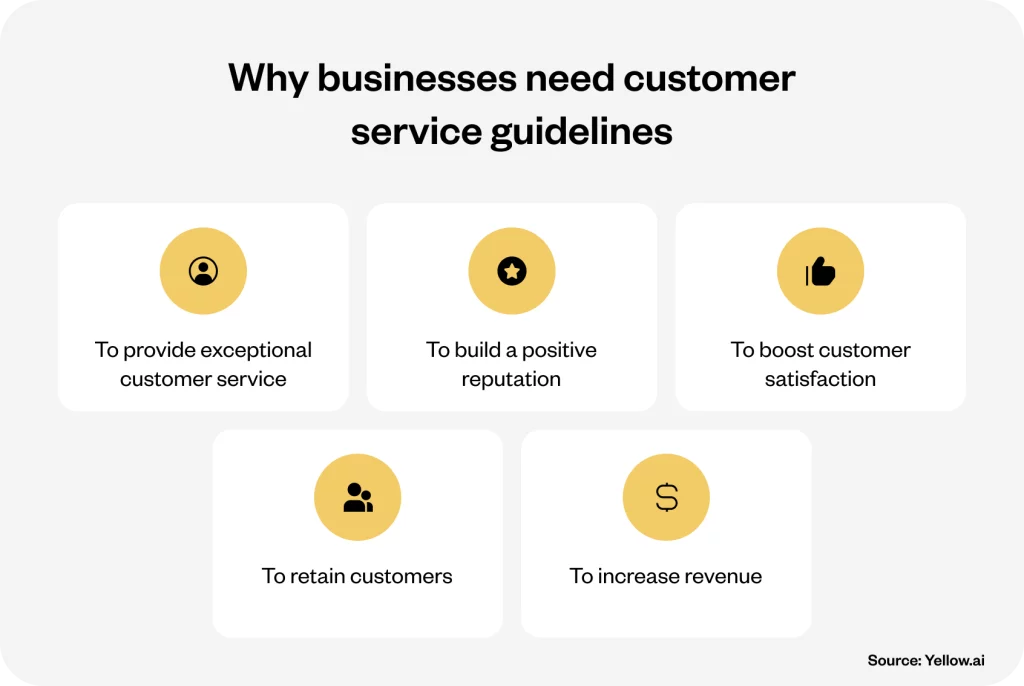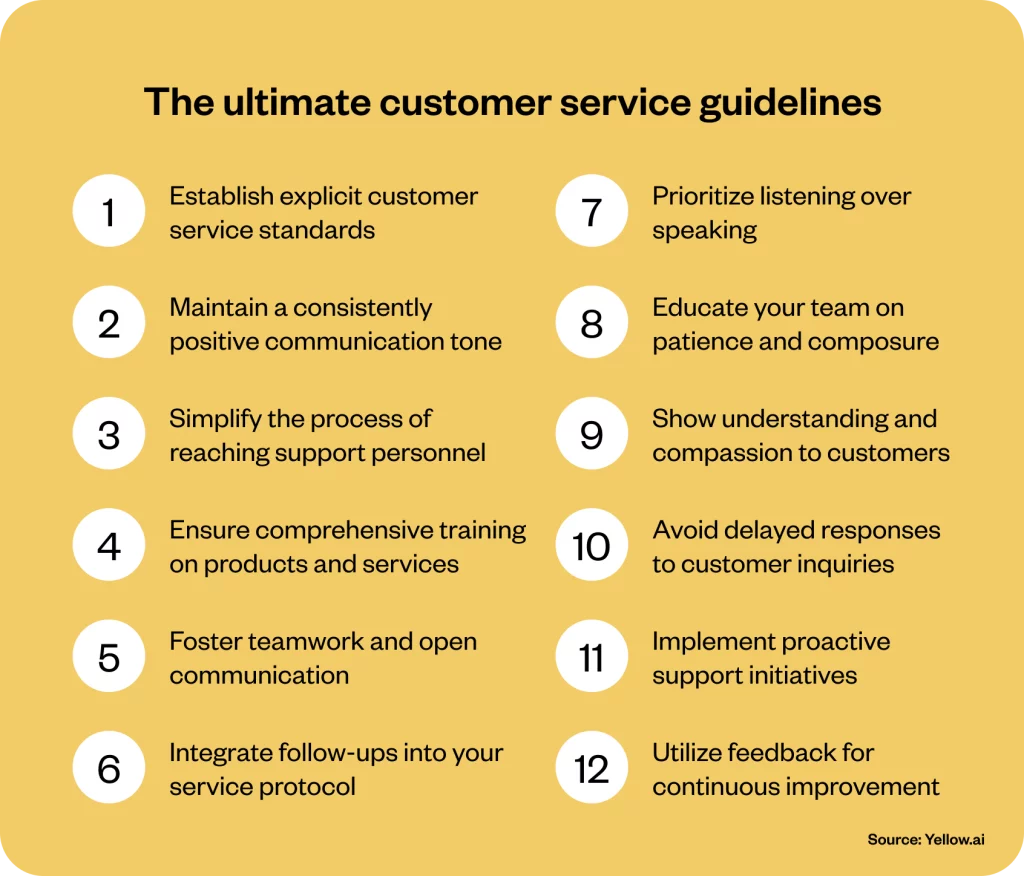Executive summary
Dive into the heart of customer-centric business strategies with the essential customer service guidelines for transformative business success. This blog offers key insights, outlining the crucial role and impact of customer service guidelines in shaping a business’s success. Discover how these guidelines enhance customer interactions and propel businesses toward growth, reputation enhancement, and revenue maximization. Ideal for businesses seeking to refine their customer service approach, this comprehensive guide lays out practical, effective principles for exceptional customer service.
Imagine entering a world where every customer interaction becomes a canvas for creating lasting impressions. That’s the essence of exceptional customer service, a mix of empathy, strategy, and commitment. It transforms ordinary interactions into memorable experiences. In today’s world, customer service transcends traditional boundaries, becoming a dynamic force that shapes customer perceptions and loyalty. Customer service guidelines are not just a set of rules; these guidelines are the roadmap to a journey into mastering the art of customer engagement. It’s where customer satisfaction leads to business growth and where every support call turns into a story of trust and loyalty.
Picture your business as a stage where each customer interaction is a spotlight moment. Here, the customer service guidelines are your script. These guidelines ensure every act is a performance of excellence. As you turn the pages of this guide, you are scripting a revolution in customer service. These guidelines are your tools to weave stories of exceptional service encounters that resonate deeply with customers, transforming them from mere consumers into loyal advocates of your brand. Read on to embark on this transformative journey.
Related must-reads:
- 10 Bad customer service examples (How to fix them)
- Customer service automation – A full guide
- 12 Customer service metrics to measure in 2024
- Should your business outsource customer service?
What are customer service guidelines?
Customer service guidelines are the compass guiding each interaction, ensuring it aligns with your brand’s core values and goals. These guidelines are the DNA of your company’s customer interaction strategy. They encompass everything from the tone of voice your team uses to the methods employed in solving problems and the overall approach to making each customer feel valued and heard.
Consider customer service guidelines as a specialized toolkit for understanding and fulfilling customer needs effectively. These are thoughtfully developed principles that transform everyday customer interactions into experiences that leave a lasting positive impression. They equip your team with essential skills in clear communication, efficient problem resolution, and understanding customer emotions. Essentially, these guidelines are the framework that helps your business consistently deliver high-quality service, nurturing a loyal customer base grounded in trust and satisfaction.
Customer service guidelines are your business’s roadmap to creating satisfied customers and transforming them into passionate brand ambassadors. They are the secret sauce to building a brand that customers love and advocate for. These guidelines are the foundation upon which businesses can build a legacy of outstanding customer service, turning every support interaction into an opportunity to reinforce their brand’s commitment to excellence and customer happiness.
Why businesses need customer service guidelines
The need for well-defined customer service guidelines in business has never been more crucial. These guidelines guide businesses in navigating the ever-evolving expectations of customers. Let’s explore why adhering to customer service guidelines is indispensable for businesses aiming to thrive in today’s competitive landscape.

1. To provide exceptional customer service
Customer expectations are constantly soaring. Hence, providing exceptional customer service is the linchpin for business success. Guidelines ensure that every customer interaction is handled with professionalism, empathy, and efficiency. This consistency in service quality can transform a one-time buyer into a lifelong patron.
Consider a bookstore that adopts a customer-first approach. When a customer struggles to find a specific book, the well-trained staff, following their guidelines, promptly assists and even recommends similar titles. This level of attentive service solves the immediate query and leaves a lasting positive impression, encouraging repeat visits.
Related reads:
- Top 10 customer service tips for 2024: Elevate your support
- 2 Customer service metrics to measure in 2024
- Customer service strategy: A step-by-step guide
2. To build a positive reputation
A company’s reputation hinges significantly on how it interacts with customers. Adhering to customer service guidelines ensures a standard of excellence that resonates through every customer interaction, thereby solidifying a brand’s reputation as customer-centric and reliable.
A tech company renowned for its responsive customer support sees an influx of new customers, drawn by rave reviews about its helpful and quick-to-respond support team. This positive reputation, built on consistent quality service, becomes a key differentiator in a saturated market.
3. To boost customer satisfaction
Customer satisfaction is a critical measure of business performance. Guidelines help ensure that customers’ needs are not just met but exceeded. It will lead to higher satisfaction levels. Satisfied customers are likely to become brand advocates, further amplifying a business’s reach.
A furniture ecommerce platform implements a hassle-free return policy as part of its service guidelines. This policy enhances customer satisfaction, as shoppers feel secure knowing their concerns will be addressed without unnecessary complications.
Related read: How to improve customer satisfaction in 2024?
4. To retain customers
Customer retention is more cost-effective than acquisition. Service guidelines help in creating positive experiences. That makes customers more inclined to stay loyal to a brand. This loyalty translates to repeat business and a stable revenue stream.
An online gourmet food service offers personalized recommendations and attentive after-sale service as part of its guidelines. These efforts result in customers returning for the curated experience, boosting retention rates.
Related read: Customer retention: 15 strategies to improve CR
5. To increase revenue
Excellent customer service directly impacts a business’s bottom line. Guidelines that focus on understanding and addressing customer needs can lead to increased sales, as satisfied customers are more likely to make additional purchases and recommend the business to others.
A beauty products brand integrates cross-selling strategies into its service guidelines. By suggesting complementary products during customer interactions, the brand sees an uptick in average transaction values, contributing to higher overall revenue.
Transform your customer service today with Yellow.ai

12 Ultimate customer service guidelines
Customer service is a defining thread in the intricate tapestry of modern business. It is shaping the very fabric of brand perception and customer loyalty. The ultimate customer service guidelines are not mere rules. Instead, these are strategies that can create an unforgettable customer experience. Let’s explore these transformative guidelines that can elevate a business’s customer service to new heights.

1. Establish explicit customer service standards
In the absence of clear standards, customer service can become a wild card, unpredictable and varied. Establishing explicit standards sets a clear benchmark for quality and consistency in customer interactions.
By implementing explicit standards, businesses can ensure uniformity in service quality, leading to a reliable and trustworthy customer experience. Businesses should define these standards in their training manuals and ensure regular reinforcement through training sessions.
Example: A boutique hotel chain sets explicit standards for guest interactions, ensuring that every staff member, from the concierge to the housekeeping team, delivers a consistent level of warmth and efficiency. This approach results in a uniform and exceptional guest experience, enhancing the hotel’s reputation for outstanding service.
2. Maintain a consistently positive communication tone
A negative or inconsistent tone can erode customer trust and satisfaction. Maintaining a consistently positive tone across all customer interactions fosters a welcoming and supportive environment.
Training staff to adopt a positive and empathetic tone, regardless of the situation, can significantly improve customer interactions. Role-playing exercises and feedback sessions can be effective in honing this skill.
Example: A customer calls an electronics company, frustrated with a malfunctioning product. The support representative maintains a positive and empathetic tone, efficiently resolves the issue, and leaves the customer feeling valued and heard.
3. Simplify the process of reaching support personnel
Complex or cumbersome processes to reach support can aggravate customer frustrations. Simplifying access to support staff enhances the customer experience and demonstrates a business’s commitment to their convenience. Businesses should streamline their support channels, making it easy for customers to get the help they need through clear, straightforward pathways.
Example: An online retailer integrates a chatbot on its website for immediate assistance, along with clear options for contacting human support. It will simplify the process and reduce customer effort significantly.
Related read: What is Customer Effort Score and how to improve CES?
4. Ensure comprehensive training on products and services
Inadequate product knowledge can lead to ineffective customer support. Extensive training ensures that support personnel are well-equipped to assist customers effectively. Regular training sessions and updates about new products and services are essential. Assessments, including hands-on experience and knowledge, can further enhance staff proficiency.
Example: A software company regularly conducts training workshops for its support team, ensuring they are adept at navigating the software and can provide insightful solutions to user queries.
5. Foster teamwork and open communication
Isolated teams can lead to disjointed customer experiences. Promoting teamwork and open communication ensures a cohesive approach to customer service. Encouraging cross-departmental collaboration and open channels of communication can significantly enhance the effectiveness of customer service teams.
Example: A healthcare provider fosters a culture of open communication among its administrative, nursing, and medical teams. It will ensure that patient care is seamless and coordinated.
6. Integrate follow-ups into your service protocol
Neglecting follow-ups can leave customers feeling undervalued. Integrating follow-ups shows customers that their satisfaction is a priority. Implementing a structured follow-up system can turn a one-time interaction into an ongoing relationship, enhancing customer loyalty.
Example: After resolving a customer’s issue, a telecommunications company follows up to ensure satisfaction with the resolution. It will reinforce the customer’s positive perception of the company.
7. Prioritize listening over speaking
Overlooking the importance of listening can lead to miscommunication and dissatisfaction. Prioritizing listening ensures that customer concerns are fully understood and addressed. Training staff to be active listeners and to ask clarifying questions can lead to more effective problem resolution and higher customer satisfaction.
Example: A customer service representative at a clothing retailer listens attentively to a customer’s unique needs and preferences. It will result in personalized recommendations that delight the customer.
8. Educate your team on patience and composure
Losing patience or composure can escalate conflicts and damage the customer relationship. Educating the team on maintaining composure under pressure is crucial for diffusing tense situations. Regular stress management training and support for customer service staff can help them remain calm and composed, even in challenging situations.
Example: In a high-pressure scenario, a customer service agent at a bank maintains composure and patiently guides a customer through a complex financial query. It will leave the customer reassured and appreciative.
9. Show understanding and compassion to customers
A lack of empathy can alienate customers. Showing understanding and compassion can transform customer interactions into positive experiences. Encouraging staff to empathize and show genuine concern can build stronger connections with customers and foster loyalty.
Example: A customer who is facing a unique challenge is met with understanding and compassion by a service agent who goes out of their way to find a suitable solution. This interaction will profoundly impact the customer’s loyalty to the brand.
10. Avoid delayed responses to customer inquiries
Delayed responses can exacerbate customer frustrations. Timely responses demonstrate respect for the customer’s time and needs. Implementing efficient response protocols and leveraging technology for quicker replies can significantly improve customer satisfaction.
Example: An auto repair service ensures prompt responses to online inquiries. It will lead to increased customer trust and repeat business.
11. Implement proactive support initiatives
Waiting for customers to reach out with problems can miss opportunities for service enhancement. Proactive support identifies and resolves issues before they escalate. Anticipating common customer issues and addressing them proactively can reduce complaints and increase customer satisfaction.
Example: A software company proactively reaches out to users with tips and resources for common issues. It will reduce support tickets and increase user satisfaction.
12. Utilize feedback for continuous improvement
Ignoring customer feedback can lead to stagnant service quality. Utilizing feedback for continuous improvement keeps service aligned with customer expectations. Regularly collecting and analyzing customer feedback and making adjustments based on insights can lead to ongoing service enhancements.
Example: A restaurant regularly solicits and incorporates customer feedback. It will lead to menu improvements and a growing loyal customer base.
Embracing these ultimate customer service guidelines can help businesses to meet and exceed customer expectations. It will also help create a path of excellence and distinction in customer service. Each guideline, when implemented with dedication and insight, becomes a stepping stone toward building a brand that is revered for its commitment to outstanding customer service.
Enhancing customer service with Yellow.ai’s advanced bot technology
Today, where customer service defines the fate of businesses, Yellow.ai stands at the forefront. We are revolutionizing the way companies interact with their customers. The integration of Yellow.ai’s advanced chatbot technology is not just an upgrade—it’s a transformative journey into the future of customer engagement. With AI-driven chatbots, businesses can now offer seamless, efficient, and personalized customer experiences, ensuring that each interaction is a delightful encounter.
24/7 customer support automation: Yellow.ai’s AI-driven chatbots provide round-the-clock support, ensuring that customers receive timely assistance anytime, complementing the guideline of avoiding delayed responses to customer inquiries.
Multilingual capabilities: Catering to a global audience, Yellow.ai’s chatbots can interact in over 135 languages and dialects, aligning with the guideline of understanding and compassion, making customers feel heard in their native tongue.
Seamless integration with CRM systems: Integrating effortlessly with existing CRM platforms, Yellow.ai ensures that customer interactions are tracked and managed effectively, supporting the guideline of fostering teamwork and open communication within customer service teams.
Advanced Natural Language Processing (NLP): Our AI chatbots understand and respond to customer queries with human-like precision, ensuring clear communication and problem resolution, which is essential for maintaining a positive communication tone.
Related read: What is Natural Language Processing (NLP) – A complete guide
Personalized customer interactions: Yellow.ai’s technology can tailor interactions based on customer history and preferences, offering personalized solutions and recommendations, thus enhancing customer satisfaction and loyalty.
Proactive customer engagement: The ability to initiate conversations based on customer behavior and preferences, aligning with the guideline of implementing proactive support initiatives to anticipate and address customer needs before they escalate into issues.
Ready to transform your customer experience? Book a demo today and experience the magic.
Case studies: Real-world success with Yellow.ai

Hyundai boosts revenue and improves customer service with AI automation
Explore how Yellow.ai’s automation led to ~1000 car sales, a 10% retail conversion rate, and over 1.4 million user impressions

Pelago reimagines customer experience with generative AI powered conversational AI agents
Within a mere six weeks of going live, Pelago not only onboarded over 5,000 users but also achieved a striking 50% deflection rate!
The final thoughts
The landscape of customer interactions is evolving rapidly. Businesses today are not just service providers; they are architects of experiences. Each guideline discussed herein is a brushstroke in painting the bigger picture of customer satisfaction and brand loyalty.
In this journey, technology is a crucial ally. Innovations like Yellow.ai’s chatbots are redefining the boundaries of what’s possible in customer service. AI chatbots bring efficiency, personalization, and a touch of future-forward thinking that resonates with the modern consumer. The integration of such technology is a necessity for businesses looking to thrive in a competitive market.
As businesses embark on this transformative path, they are building legacies. Each interaction, powered by thoughtful customer service guidelines and innovative technology, becomes a step towards a future where customer service is the heart of a brand’s identity. It’s time to embrace this change to build a community of brand advocates.
In the end, the accurate measure of success in customer service is not just in the solutions provided but in the stories created, the relationships forged, and the experiences that echo beyond the immediate interaction. Here’s to crafting a future where every customer feels heard, valued, and delighted—where every brand is not just a name but a story of exceptional service.




















